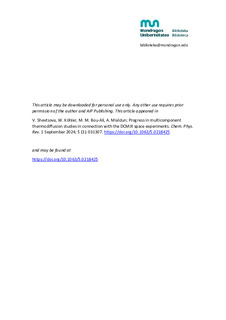Izenburua
Progress in multicomponent thermodiffusion studies in connection with the DCMIX space experimentsArgitalpen data
2024Beste erakundeak
Universität Bayreuth (Alemania)Université Libre de Bruxelles
Bertsioa
Bertsio argitaratuaDokumentu-mota
ArtikuluaArtikuluaHizkuntza
IngelesaEskubideak
© 2024 AIP PublishingSarbidea
Sarbide bahituaArgitaratzailearen bertsioa
https://doi.org/10.1063/5.0218425Non argitaratua
Chemical physics reviews Argitaratzailea
AIP PublishingGako-hitzak
oil
laboratory procedures
Microgravity
thermodynamics ... [+]
laboratory procedures
Microgravity
thermodynamics ... [+]
oil
laboratory procedures
Microgravity
thermodynamics
Thermophoresis
data processing
space stations
interferometry
mass diffusivity
thermal diffusivity [-]
laboratory procedures
Microgravity
thermodynamics
Thermophoresis
data processing
space stations
interferometry
mass diffusivity
thermal diffusivity [-]
UNESCO Sailkapena
Fluidoen fisikaTermodinamika
Laburpena
Understanding of thermodiffusion in ternary mixtures has made significant progress during the course of the DCMIX (Diffusion and Thermodiffusion Coefficients in ternary mixtures) microgravity experime ... [+]
Understanding of thermodiffusion in ternary mixtures has made significant progress during the course of the DCMIX (Diffusion and Thermodiffusion Coefficients in ternary mixtures) microgravity experiments onboard the International Space Station (ISS). Here, we give a short overview of the four DCMIX campaigns that were successfully launched between 2012 and 2018. Essential for the success was a detailed understanding of the impact of residual vibrations on the thermodiffusion experiments. A systematic analysis was performed during the Influence VIbration on DIffusion in Liquids campaign and accelerations were monitored during the DCMIX experiments. Two-color optical techniques, as employed in the Selectable Optical Diagnostics Instrument experiment on the ISS, are frequently used to separate the two independent concentrations in a ternary mixture. We describe the essential ideas and methods for data processing. In any case, a frequently ill-conditioned contrast factor matrix needs to be inverted, which leads to a strong error amplification along a certain direction in the ternary composition space. Exemplarily, we discuss major outcomes of the DCMIX campaign and related laboratory experiments. A benchmark for ternary mixtures was established by a detailed comparison of DCMIX1 microgravity data and ground-based measurements. Other than in binary mixtures, cross-diffusion can provide a significant contribution to the separation in the Soret equilibrium. A newly developed approach introduces Soret vectors to describe the local composition variation over the entire Gibbs triangle. For the DCMIX3 system, the existence of a singular point could be demonstrated, where all three Soret coefficients vanish simultaneously. The difficult inversion of the contrast factor matrix can be avoided in situations where additional a priori assumptions can be made, e.g., polymers or colloids in mixed solvents. [-]





















